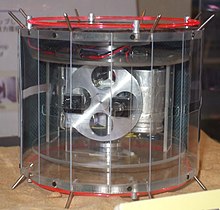Micro / Nano Experimental Robot Vehicle for Asteroid
Micro / Nano Experimental Robot Vehicle for Asteroid (abbreviated MINERVA ) are rovers for planetary exploration of the Japan Aerospace Exploration Agency (JAXA). The first MINERVA was part of the Hayabusa mission to the asteroid (25143) Itokawa . Two further developed MINERVA-II landing robots were deposited on the asteroid (162173) Ryugu as part of the Hayabusa 2 mission .
Hayabusa
The small landing robot weighed only 591 grams. It was shaped like a 16-sided prism, 12 cm in diameter and 10 cm in height. It was equipped with three cameras and six temperature sensors. The energy was supplied by solar cells attached to the surface, which delivered 2 watts. In contrast to many NASA rovers , the JAXA decided to choose a different form of locomotion. MINERVA should hop on the surface of the asteroid .
Both the actual Hayabusa spacecraft and MINERVA were intended for landing on the asteroid. Before the space probe lands, MINERVA should therefore be dropped on the target area on Itokawa in order to send recordings and data from there in order to prepare the later sampling.
The rover's landing on the asteroid failed on November 12, 2005, as the probe was suspended due to a timing error, while Hayabusa was already moving upwards away from the asteroid after approaching the surface. As a result, Minerva exceeded the escape speed necessary to overcome the asteroid's gravity and was lost in space. Nevertheless, it was still possible to take pictures of the Hayabusa space probe and transmit them to earth via radio.
Hayabusa 2
As part of the Hayabusa 2 mission , three further developed MINERVA-II landing robots were transported to the asteroid (162173) Ryugu and, as JAXA announced on September 22, 2018, two of them, MINERVA-II2 1a and 1b, were successfully on the surface of the asteroid discontinued. They were u. a. Take photographs and measure the temperature in preparation for the landing of MASCOT . After completing the exploration, they remained on the asteroid. A fourth rover, MINERVA-II 2, was scheduled to land in October 2019; During the separation, control of the rover was lost and it crashed on the asteroid after experiments were carried out on the approach.
Individual evidence
- ^ MINERVA explores the surface of ITOKAWA. JAXA, November 3, 2005, accessed April 7, 2013 .
- ↑ anxiously Awaiting the Fruits of Our Labor. JAXA, accessed April 7, 2013 .
- ↑ The Standard : Two Japanese small robots land on asteroid Ryugu , September 22, 2018
- ^ Hajime Yano: Microgravity Geology: A New Challenge for Human and Robotic Space Exploration. (PDF, 51 pages, 5 MB) (No longer available online.) February 20, 2013, p. 46 , archived from the original on April 11, 2013 ; accessed on April 7, 2013 . Info: The archive link was inserted automatically and has not yet been checked. Please check the original and archive link according to the instructions and then remove this notice.

